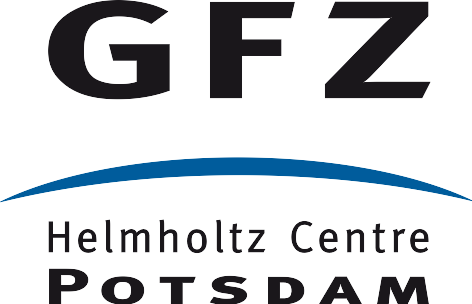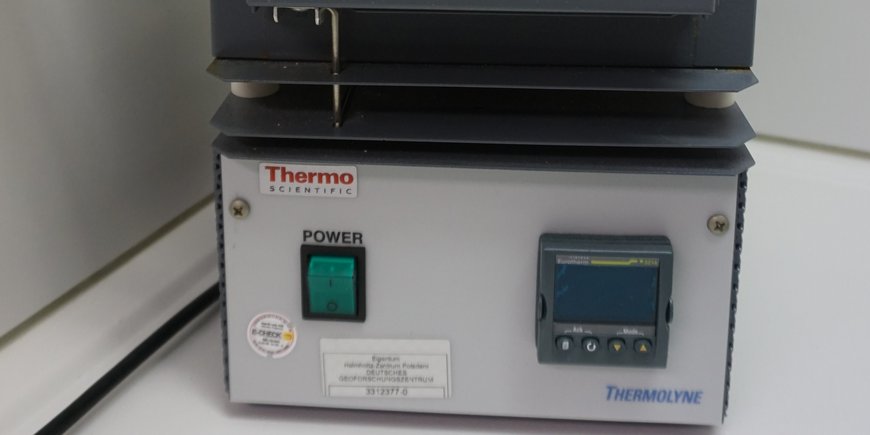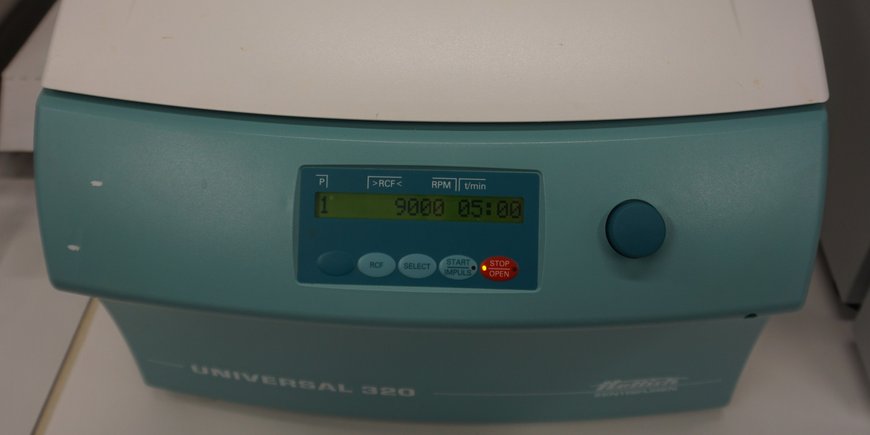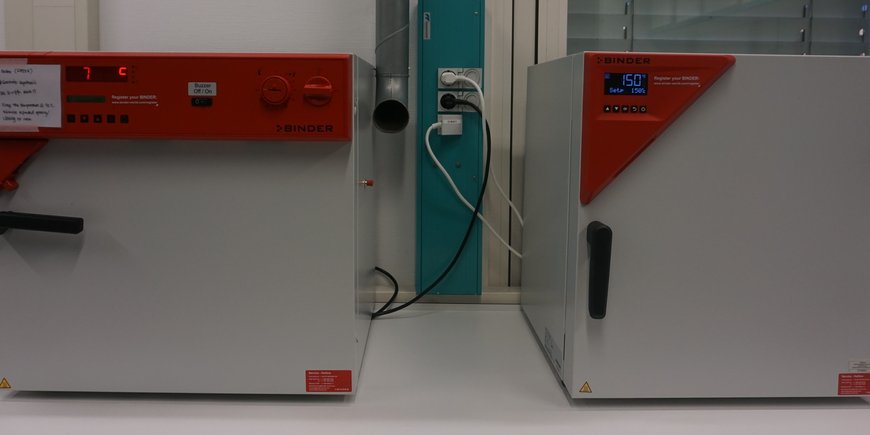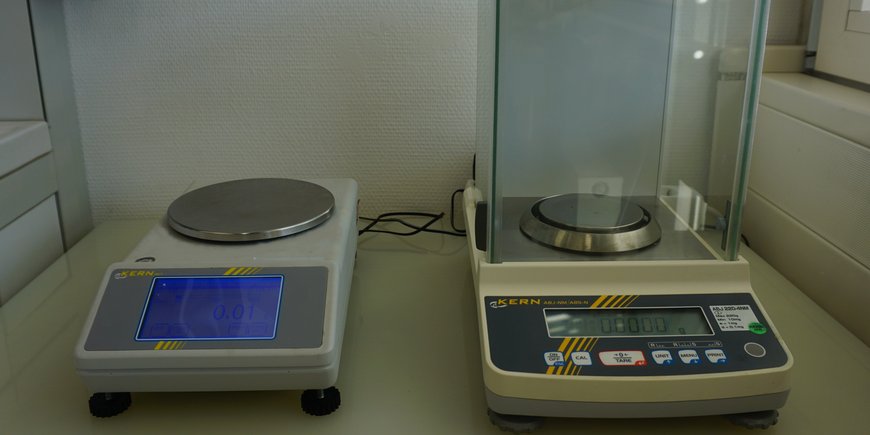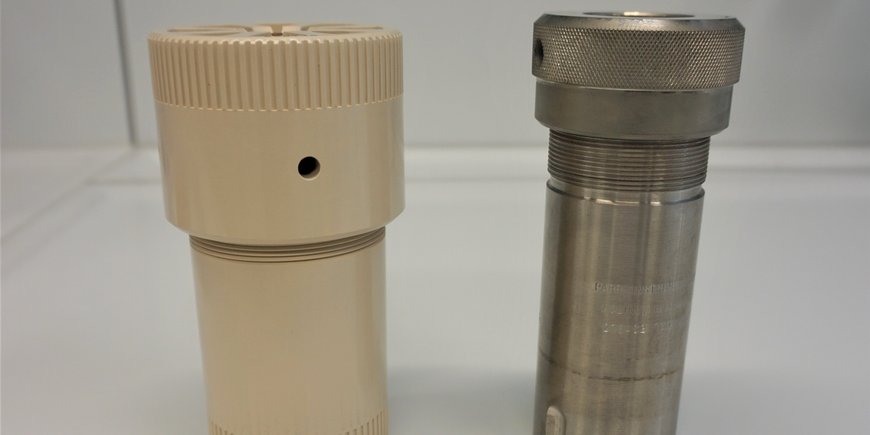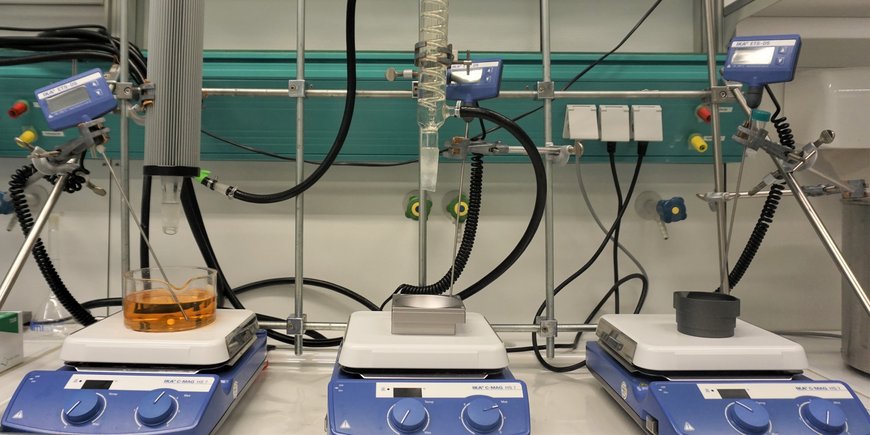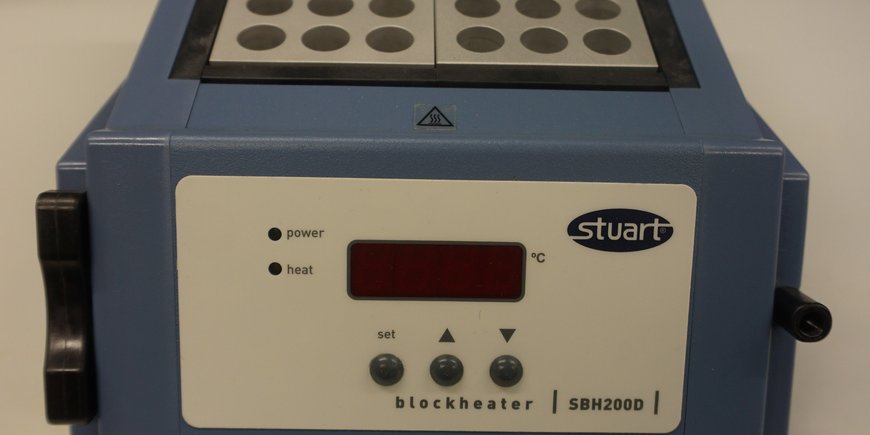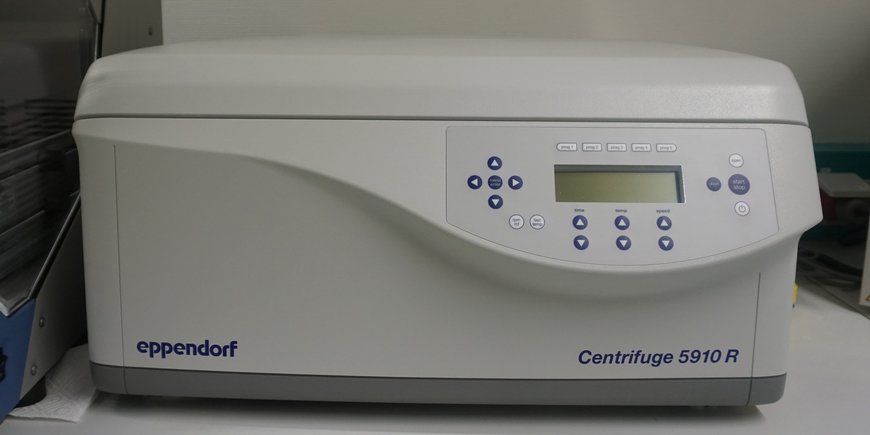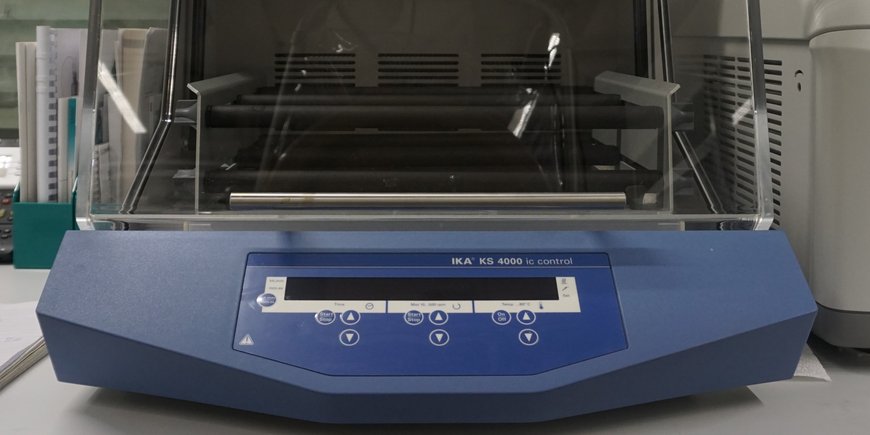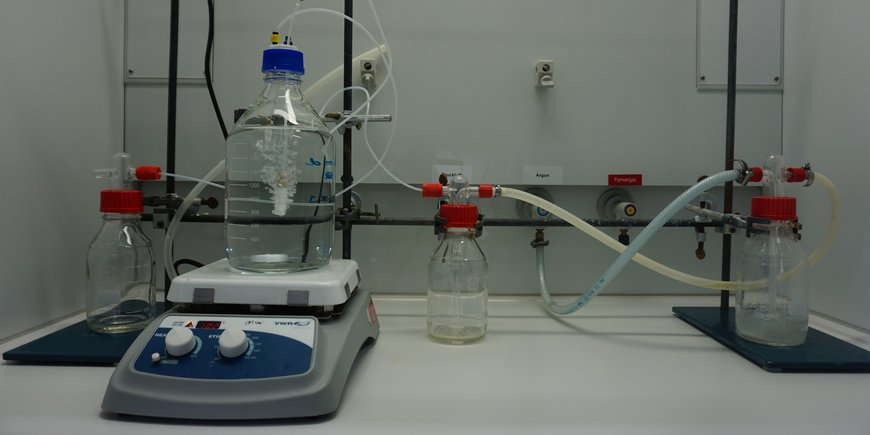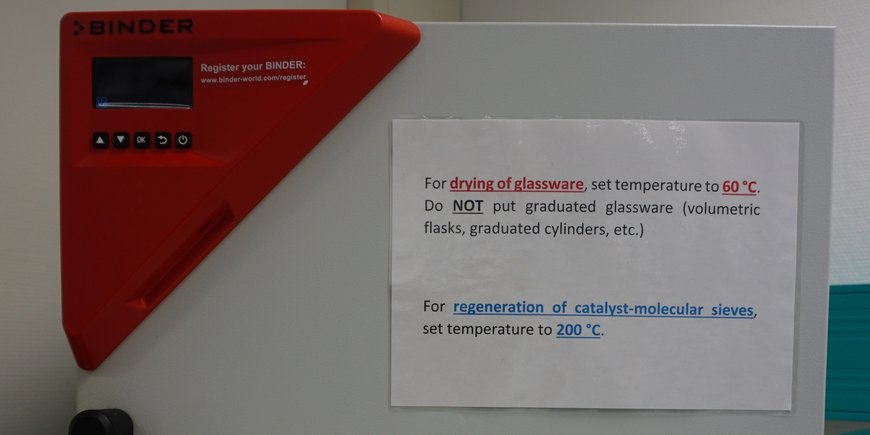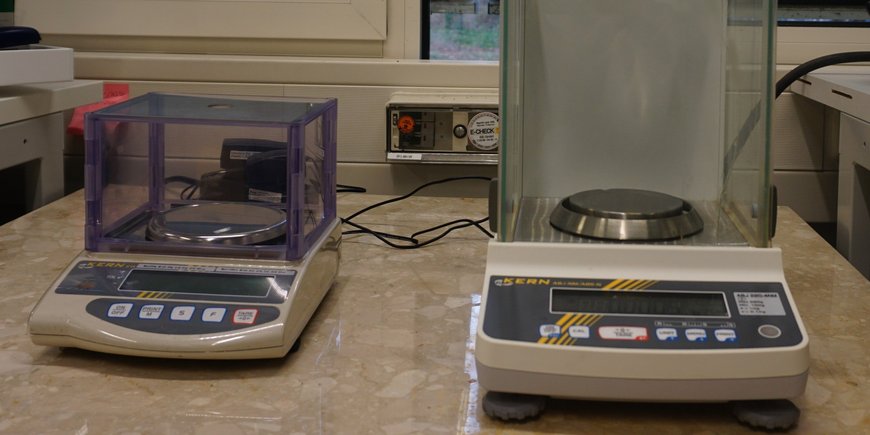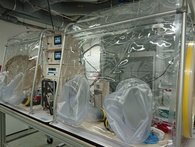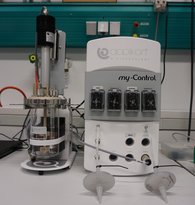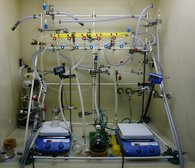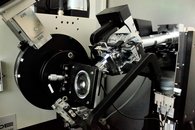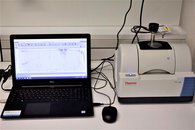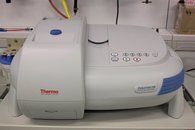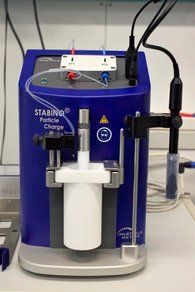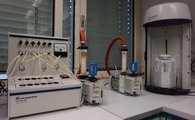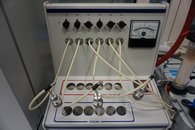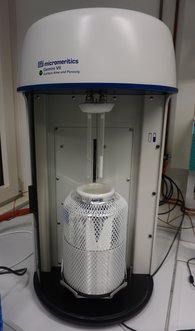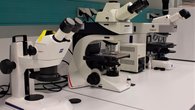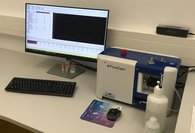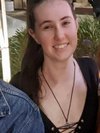Mineral Synthesis Laboratory
Our section employs a wide range of nature-inspired or nature-mimicking mineral synthesis, as well as entirely artificial synthetic approaches, to produce various minerals and study their formation and/or transformation. To enable this research, our labs are equipped to perform inorganic and organic material synthesis and characterization using a wide-range spectroscopic and scattering techniques. More detailed information about our labs and analytical capabilities can be found in the individual descriptions below.
Location: C358 and C360
This lab is dedicated to mineral synthesis and other experiments using mostly inorganic chemistry or hydrothermal synthesis methods. The lab is equipped with standard chemical laboratory equipment such as analytical balance, centrifuge, fume hood, furnaces, hotplate stirrers, ovens, dry block heater, pH meters as well as reflux setups and sonicator bath. Hydrothermal synthesis is possible in closed Teflon lined cells heated either conductively or by microwave irradiation.
Location: C164
This lab is dedicated for the synthesis of redox-active iron mineral phases, as well as their interaction with redox-sensitive trace elements (e.g., As, Cr,) and anaerobic microbes, under oxygen-limited conditions. It is equipped with two anaerobic chamber workstations, setup for liquid degassing to remove O2, sample autodiluter for trace element analysis and standard chemical laboratory equipment such as analytical balance, centrifuge, fume hood, hotplate stirrer, shaking incubator, oven and pH meters.
Main equipment:
COY Vinyl Anaerobic Chamber
Contact: Marc Christian Paje
The anaerobic chamber (97% N2 / 3% H2, Coy Lab Products) is a heavy duty, flexible vinyl chamber that allows us to synthesize Fe(II)-bearing iron mineral phases (e.g., nZVI, green rust, magnetite, iron sulfides) that oxidize in air. The chamber has a strict anoxic atmosphere (< 5 ppm O2), which is maintained by the catalytic reduction of O2 using H2 (~3%) by the reusable palladium-coated alumina Stak-Pak in front of recirculating fans. The humidity in the chamber is also kept low by extra alumina desiccant Stak-Pak. The H2 levels inside the chamber is kept at ~3% at all times using an automatic gas mix infuser that is connected to an H2/O2 gas monitor (CAM-12).
Our anaerobic chamber has two workstations separated by a vacuum airlock which allows rapid sample transfer without changes in chamber atmosphere. One of the workstations is used for mineral synthesis and is equipped with multi-position stirrers and an autotitrator. The other workstation is mainly used for mineral processing and anoxic sample preparation for solid-state characterization. Since there are two separate workstations, it is also possible to operate them under different gas atmospheres (i.e., one with 97% N2 / 3% H2 and the other with 87% N2 / 10% CO2 / 3% H2).
Contact: Marcin Syczewski
Location: C359
This lab is dedicated to mineral and mineral precursor synthesis using organic chemistry or advanced inorganic chemistry methods requiring special conditions, such as anoxic and/or anhydrous atmosphere or the use of hazardous chemicals. For this purpose it contains all the equipment necessary to perform almost any chemical process reasonably expected in synthetic chemistry. The lab is also used to produce starting materials to be used in other projects if obtaining them commercially is impractical or not possible. The lab contains the following significant equipment: Ar/Vacuum manifold (Schlenk line).
Our Mineral Synthesis Lab complex is equipped with a very diverse suite of spectroscopic and scattering instruments to determine material chemical composition, structure, surface area and grain size of both synthetic and natural samples.
Main equipment:
Powder X-ray diffractometer STOE StadiP
Contact: Dr. Pablo Forjanes, Rebecca Volkmann
Location: B360
Our powder X-ray diffractometer (XRD) consists of two individual instruments capable of X-ray scattering analysis using both Cu (λ=1.54 Å) and Ag radiation (λ=0.56 Å) in transmission geometry. XRD can be used to analyze both crystalline and amorphous samples by measuring either conventional diffraction patterns or high Q-range total scattering patterns for pair distribution function (PDF) analysis. Measurements can be performed in room or elevated temperature up to 800 ⁰C.
Cu radiation is more suitable for general structure analysis of crystalline samples. Samples may be analysed in either Debye-Scherrer (capillary) or flat plate geometries. Multi-sample changers are available for both geometries. The Cu-XRD is fitted with a curved Ge (111) monochromator in the incident beam and the scattered X-rays are detected with a DECTRIS MYTHEN2 R 1k photon counting detector.
Ag radiation is more suitable for PDF measurements or materials that are fluorescent in the Cu X-Ray radiation such as Fe-rich materials. Samples may be analyzed in either Debye-Scherrer (capillary) or flat plate geometries. A high temperature furnace is available for samples in Debye-Scherrer geometry. The Ag-XRD is fitted with a curved Ge (111) monochromator in the incident beam and the scattered X-rays are detected with two DECTRIS MYTHEN2 R 1k photon counting detectors.
FTIR spectrometer ThermoFisher Nicolet iS5
Contact: Dr. Pablo Forjanes
Location: C359
The IR spectrometer is used for fast routine IR spectra acquisition in the 4000-400 cm-1 range with a maximum resolution of 0.9 cm-1, although in practice higher resolution than 4 cm-1 is seldom necessary. IR spectra can be measured on both liquid and solid samples. The measurements are usually performed using the diamond attenuated total reflectance (ATR) accessory that allows to obtain a spectra in a few minutes with no sample preparation of very small (<1 mg) sample quantities. Measurements of KBr pellets or similar samples in transmission geometry are also possible. List of accessories available:
- iD7 diamond ATR (most commonly used)
- iD1 transmission
- iD1 in-situ probe with Si ATR tip
- iD Foundation multi-bounce ATR with either ZnSe or Ge prism
UV-Visible spectrophotometer ThermoFisher Evolution 220
Contact: Dr. Jeffrey Paulo Perez
Location: C358
The UV-Visible (UV/VIS) spectrophotometer measures absorption of light in 190-1100 nm range. Measurements are possible in either ex-situ mode in cuvettes or in-situ using an external probe. The instrument is mostly used for the determination of elemental concentrations (e.g., Fe2+, As, Si, P) using well-established colorimetric methods. In addition, the spectrophotometer can also be used for the in situ and real-time monitoring of the nucleation, crystallization and growth of minerals, and is equipped with Single Cell Peltier System for temperature control and sample stirring.
Particlemetrix STABINO particle charge mapping
Location: C358
This instrument measures the size and ζ-potential of suspended particles, with an error of 2%. The volume of the measuring cell is 10 mL and the detected size range is between 0.3 nm - 300 μm. The addition of titrants is possible and controlled via two tanks by delivering solutions to the suspension.
Micromeritics Gemini VII gas sorption analyzer
Contact: Dr. Jeffrey Paulo Perez
Location: C358
The gas sorption analyzer is used to determine surface area and pore volume of solid materials. Measurements are usually done using nitrogen gas at the boiling point of nitrogen (77 K). The surface area of the material is determined by measuring the amount of gas sorbed onto the surfaces (cm3 N2 STP per g solid) at increasing pressures (adsorption) or decreasing pressures (desorption). The obtained N2 sorption isotherm at varying pressures can be used to distinguish between varying surfaces, outer surfaces, macro-, meso- and microporous surfaces. The BET (Brunauer, Emmett and Teller) theory is commonly used to determine the specific surface area of most solid materials. For porous materials with very narrow micropores (<2 nm), other adsorbent gases need to be used such as argon at 87 K for zeolites and MOFs, and carbon dioxide at 273 K for carbonaceous materials (i.e., activated carbon, nano- and mesoporous carbons).
Related publication:
Figueroa Campos, G. A., Perez, J., Block, I., Sagu, S. T., Saravia Celis, P., Taubert, A., Rawel, H. M. (2021): Preparation of Activated Carbons from Spent Coffee Grounds and Coffee Parchment and Assessment of Their Adsorbent Efficiency. - Processes, 9, 8, 1396. DOI: 10.3390/pr9081396
Krone, L. V., Hampl, F., Schwerdhelm, C., Ganzert, L., Kitte, J. A., Übernickel, K., Dielforder, A., Aldaz Cifuentes, S. R., Oses-Pedraza, R., Perez, J., Sanchez-Alfaro, P., Wagner, D., Weckmann, U., von Blanckenburg, F. (2021): Deep weathering in the semi-arid Coastal Cordillera, Chile. - Scientific Reports, 11, 13057. DOI: 10.1038/s41598-021-90267-7
Hövelmann, J., Stawski, T., Besselink, R., Freeman, H., Dietmann, K. M., Mayanna, S., Pauw, B. R., Benning, L. G. (2019). A template-free and low temperature method for the synthesis of mesoporous magnesium phosphate with uniform pore structure and high surface area. Nanoscale, 11, 14, 6939-6951. DOI: 10.1039/C8NR09205B
Optical Microscopes
Location: A71 - 211
For general sample examination, optical microscopes (potentially with immersion oil) are also available in the Mineral Characterisation Lab. Microscopes available:
- Zeiss Stemi 305
- Zeiss Axio Scope.A1
- Zeiss Jenapol
- Leitz LaborLux 11 POL
We also have the FlowCam 5000 by Yokogawa, which is a particle analyzer capable of taking optical images. It is comparable to a flow cytometer and features a syringe pump and 100 x 700 µm glass capillary, where liquid passes through. During a sample run, images of the flow are taken with a camera, magnified with a 10x objective. Detected particles are compiled as images in a collage, which can then be grouped and classified by the user based on the particle properties (e.g. size description and morphology, among others) provided by the software. Sample volume ranges from 0.25 to 1 mL.
The FlowCam provides:
- fast data acquisition
- capability to distinguish various particles of the same size and morphology
- large sample volume compared to traditional methods like hemocytometry
- detailed statistics for number and volume of particles in environmental and laboratory samples.
The contact person for the FlowCam 5000 is Sven Peters.
